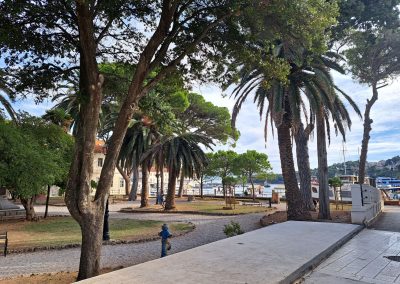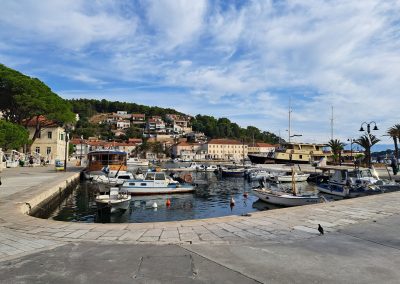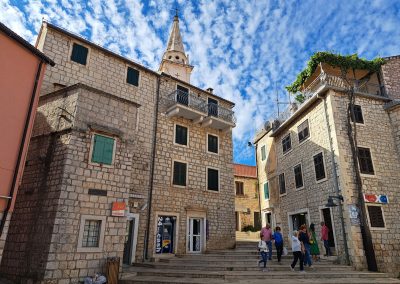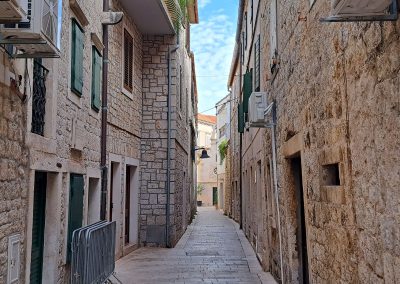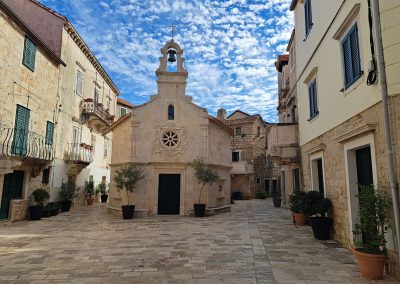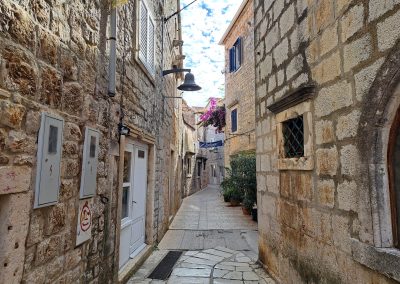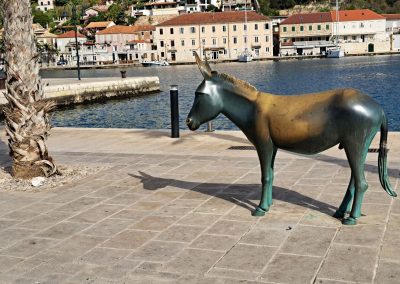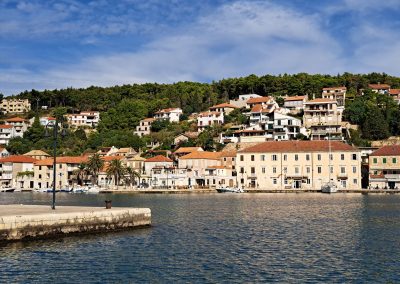Jelsa, otok Hvar
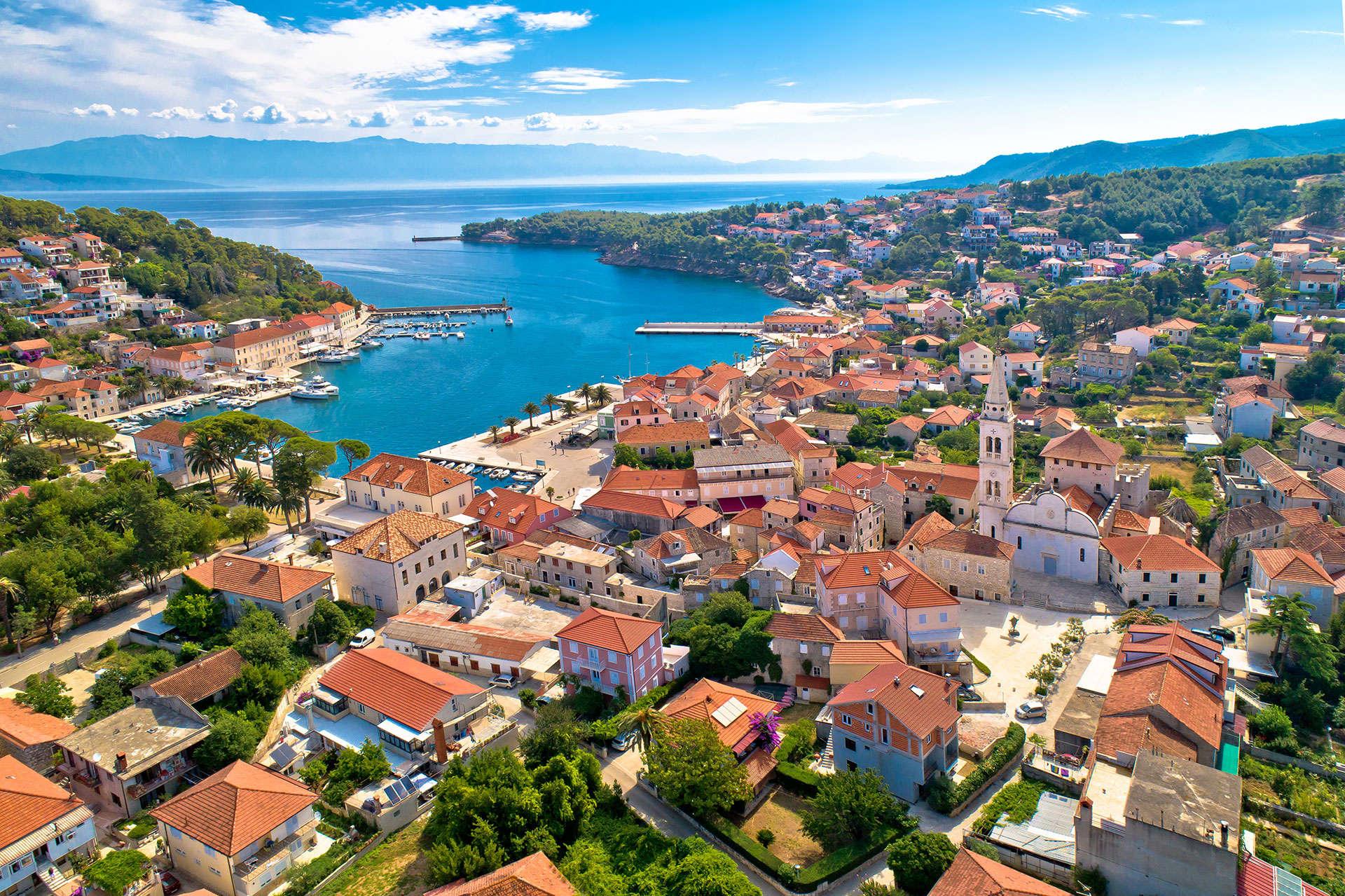
Jelsa
The municipality of Jelsa covers 55% of the island of Hvar. City of Jelsa in 1900. it had 1,550 inhabitants, and in 2021, 1,750 inhabitants.
The municipality of Jelsa had 6,600 inhabitants in 1900, and 3,500 in 2021.
Although the number of inhabitants in the municipality of Jelsa has almost halved, the city of Jelsa has seen an increase in the number of inhabitants. In this sense, the city of Hvar has seen an even greater increase in its population, from 2039 in 1919 to 3519 in 2021.
South of Jelsa towards Pitva, there are the remains of an Illyrian fortress from the 4th century BC. Kr. called Kula Tor, from which the Pitovans most likely controlled the coast on which today’s Jelsa was built. On the Gradina peninsula, separated from Jelsa and “everything” by a defense wall about 180 m long and 2.5 m high, was the Old Jelšan town with the Galešnik refuge, which is mentioned in the Hvar Statute from 1331. However, those two forts do not seem to be sufficient for defense against the Saracen attack on the island of Hvar in 1571. during which Vrboska was destroyed in the immediate vicinity, but Jelsa was not. The towns of Hvar and Stari Grad were also destroyed and burned, while Jelsa defended itself. Above Jelsa was built the church – fortress of St. Mary in the 13th-14th century, and in the 15th century the church of St. John with the main square and the church of Our Lady of Health. Church of St. Fabijan and Sebastian since 1535. has a fortification form. After the Cyprus War in 1573. , was additionally determined. The protector of the city of Jelsa is the Virgin Mary.
During the Austrian rule in 1868, a Croatian reading room and library was opened in Jelsa, and in 1870 at the entrance to Jelsa, a beautiful garden was built, a real huge “cooler” during the summer heat. It was most likely made by the Austrian institute in which later, in 1900, Robert Koch, an expert on malaria and TB, also meliorated the marshy islands of Brijune near Psu ula as a contribution to the fight against malaria. All of this probably would not have happened if in 1866 the Austrian navy, in which 2/3 of the Croats were, had not defeated the Italian fleet, which was twice as large but obviously not stronger, in the Battle of Vis. The battle was fought as part of the Austro-Prussian War, whose ally was Italy, which wanted to use the opportunity to take its own from Austria, but “got its own”. Compared to Italy, Austria was a welcome guest on the eastern coast of the Adriatic. All Croatian cities, towns and villages built a stone breakwater and port, and in 1875 Joseph I disembarked in Stari Grad, at the port that was built during the Austrian rule. The island of Mali Lošinj became the emperor’s summer residence, Opatija was built with hotels and summer houses, and the town of Hvar in 1900. founded the “Hygiene Society”. During World War II, the Italian fascist army came to Hvar and burned Vrbanj, including the church of St. Spirit, against whom to sin, according to Christ, is the only thing that is unforgivable…
The history of Hvar since the arrival of Christianity is full of controversies and “Christian dialogues”, because history, in fact the human spirit, brought the focus of consciousness to manifest and build in that way.
Today, Jelsa is surrounded by 14 bays and beaches. Camp is located next to Mina beach, Prapatnja cove has about twenty houses right next to the beach, and Mala Stiniva beach has ten houses.
Bočić and Vitarnja beaches are on the left side of the Jelšan bay, in the Mina bay is the Jelsa Aquapark. A shallow beach for children, Grebišće, also with Camp, and Zenčišće, are in bays south of Jelsa.
From 15.7. until 15.8. the city of Jelsa organizes the cultural manifestation “Days of Antun Dobronić”, a composer who in the first half of the 20th century based music on melody and polyphony, introducing “modernism” into traditionalism, i.e. folk melos. The name of Jurj Dobrović, an abstract painter also born in Jelsa, whose harmony is harder to reach and less immediate than the “aesthetic” taste that is certainly led by Grgo Gamulin, a synonym for the great Croatian art historian, interferes. “Imagination” where art and religiosity meet is an extremely suggestive and suggestive symbiotic tandem, carved by Hegel with the concept of “Self-conscious dawn”, the assertion that there is nothing in nature as “beautiful” as in the Spirit, but it is a topic that “pains head” and to which not a single Croatian art historian agreed, rejoicing in his eloquent indolence – the calming apaurin of the “naturally beautiful”.
“The One” – the Divine. Everyone is lulled by the limit up to which they can understand…we are only boundless in Spirit. j. “naked”.
